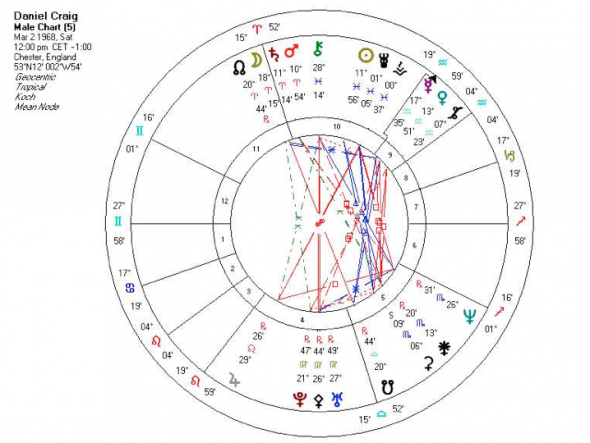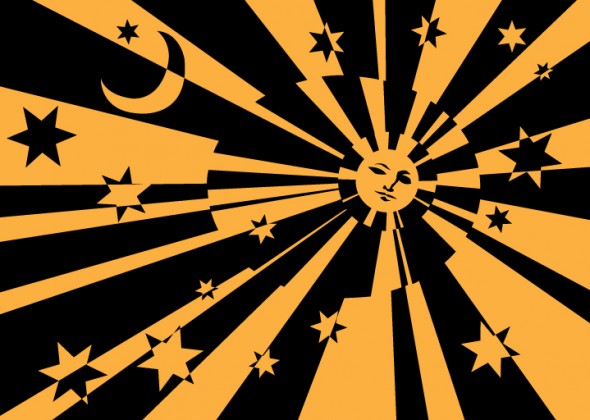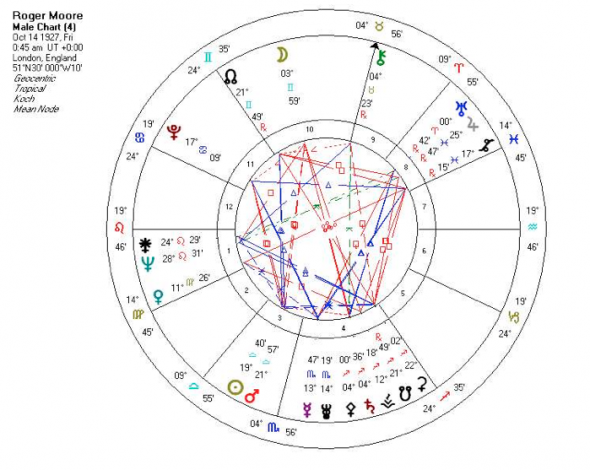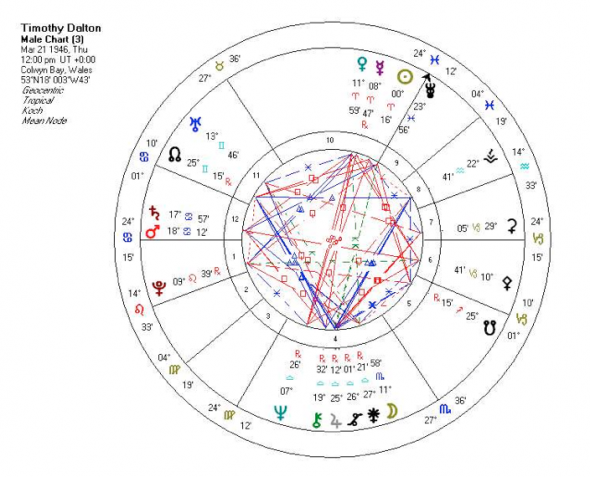“But James, I need you!”
“So does England!”
–The Spy Who Loved Me
Even though he returned to star in 1971’s Diamonds Are Forever, Sean Connery turned out not to be eternally bound to an eternal Bond. After Connery finally bailed, the producers, having had a single dalliance with a frustrated George Lazenby, went back to someone they had thought about hiring for several years—the great English “Saint,” Roger Moore.
Like Lazenby, Moore had started out as a model. Always a clotheshorse, he was once known as “the Big Knit.” In 1962, he was cast as Simon Templar in the British TV show, “The Saint.” It ran for 118 episodes, and after he was cast with Tony Curtis in the early ’70s show, “The Persuaders,” Roger Moore was the highest paid TV actor in the world. Intriguingly, “The Saint” premiered on the telly one day before the first Bond film, Dr. No, premiered in theatres. Bit of a strange bond for those who played Bond.
Read Part One of The Astrology of Bond
Roger Moore turned out to be the longest-running Bond, doing more official Bond films than any other actor in the role. From 1973 to 1985, Moore was more, starring in Live and Let Die, The Man With the Golden Gun, The Spy Who Loved Me, Moonraker, For Your Eyes Only, Octopussy and A View to a Kill. With Moore as 007, the series took a turn for the absurd, with jokey lightness and outlandish gadgetry replacing Cold War deadliness. Any series that features a villain with steel teeth named “Jaws”—twice!—is not begging to be taken seriously. But then, the 1970s wanted to forget the 1960s anyway. So the stunts became the movies.
This also was in keeping with the times. The Uranus-Pluto conjunction, that volatile, revolutionary energy that was the true cause of the social upheaval of the Sixties, was uncoupling itself and the energetic effect was a desire to find one’s bliss. As Uranus (the impulse toward freedom) entered Libra, sign of relationships, followed at a distance by intensely transformative Pluto, the emphasis shifted toward more personal issues. Women’s liberation, gay rights and various indigenous peoples’ movements sprang up. Neptune (idealism) also entered the playful, questing sign of Sagittarius, bringing forth a flowering of yoga practice and New Age teaching. Disco replaced socially conscious rock’n’roll. The Cold War thawed a bit, and 007 seemed much less relevant in the age of détente. Nevertheless, the franchise continued.
What was it in Roger Moore’s astrological makeup that allowed him to play the role and fit the times so well? Let us look at his chart:
Moore was born under Libra (sign of elegance and artistry) with Mars (planet of willpower/conflict) sitting close to his Sun in the 3rd House of communication. Sophistication and polish, blended with sex appeal and wit, made Moore a splendid example of someone who could pull off an iconic role and look like he wasn’t even breaking a sweat. The audience found his Bond easily digestible.
Moore’s Gemini Moon sits high in the chart in the 10th House of status, giving him a public destiny and personal attractiveness. His image as a quick wit and smooth talker (again, Gemini Moon) was developed in his previous acting roles and elevated by the Bond producers to the point where the audience almost anticipated some drollery after a heavy action scene. Moon in Gemini is nothing if not a lover of language.
But it’s the Leo Ascendant that really made Moore so popular. Leo, after all, just loves spectacle. He was also born under the conjunction of Jupiter (blessings) and Uranus (sudden change)—called by astrologers the “Thank you, Lord!” energy. Roger Moore is just naturally lucky. Like Marilyn Monroe, Moore has Neptune (glamour/film) rising in Leo in the 1st house, creating a charismatic image that he used well.
During his time as Bond, both Uranus (forward thinking) and Pluto (power issues/sexuality) were moving back and forth over his Libra Sun and Mars. Like Connery before him, he simply fit the zeitgeist. The movies had varying critical reception, but Moore as Bond almost became a cultural institution. But—when intense Pluto went into Scorpio in the mid-’80s and the social scene darkened amid the AIDS crisis, the producers rethought the role and gave it to a younger actor who projected a more serious image.
Here is the chart of Timothy Dalton:
As with George Lazenby, we do not have an exact time of birth for Dalton, but one look at the aspects tell us that he is a formidable individual.
Timothy Dalton was born under rough-hewn Aries, the opposite sign from Roger Moore’s polished Libra Sun, and the contrast between their interpretations of Bond could not be more different. A classically trained Shakespearean actor, Dalton had been considered for the part of James Bond as far back as Sean Connery’s departure in the early 1970s. He was deemed too young then, but just the right age when Moore was done.
Dalton made two Bond films, The Living Daylights and Licence to Kill. The former was praised as a return to Bond being the “blunt instrument” envisioned by Ian Fleming, while the latter finally hit theaters after a 4-year legal wrangling that drained much of the life out of the franchise; even Dalton’s portrayal was considered substandard. What accounted for such wide critical opinions and tumult in Dalton’s life?
Dalton has three planets in Aries, making him an assertive type who probably loved guns, swords and fighting anyway, and found a positive way to channel it. Mars (energy/conflict) is the ruler of Aries and sits extremely close to Saturn, planet of authority. This aspect is pretty ruthless. Dalton’s Bond is cold-eyed and dour with little of the lightheartedness of Moore’s performance. Add in Pluto, lord of the underworld, sitting in an almost exact angle to Dalton’s Mercury (intelligence) and Venus (love of beauty), and you have an actor who brings plummy speech and some realism to his role. But as Bond, he’s also been called dull. At least his Moon is in sexy Scorpio, giving him emotional intensity.
During the period that Dalton was playing 007, transiting Pluto (magnetic power) sideswiped his Moon—which in the case of an actor represents the audience. This gave him high visibility, but saddled him with proximity to power plays, which manifested as long infighting between the studio and producers. He grew discontented with the delays and direction in which the series was headed and gave his notice that two films were enough.
This time frame (late 1980s to early 1990s) had as its prime astrological signature the coming together of three planets in the restrictive sign of Capricorn, called by astrologers “the Capricorn Climax.” The expansive Saturn-and-Uranus-in-Sagittarius energy that gave Dalton good reviews when The Living Daylights came out in June, 1987, turned ultra-serious when it joined Neptune in Capricorn in 1988, and stayed that way for several years. In the U.S., there was a deep economic recession.
Capricorn is the sign of government, and when Cap’s ruling planet Saturn (business matters/traditions) moved into its own sign and hung out with Uranus (chaotic change) and Neptune (dreams/ideals), the energy was not conducive to staying with something that wasn’t working. Lest we forget, the Berlin Wall fell in 1989 and much of Europe changed. After a dismal showing in his second Bond film because of poor marketing and a lethargic performance, it was felt that James Bond would need a freshening up, too.
That left the door open for an actor already playing a suave TV detective who was a close approximation of Bond. The Broccoli family, producers of the Bond series, had wanted Pierce Brosnan even before Timothy Dalton, but NBC wouldn’t let Brosnan out of his contract for “Remington Steele.” When the series ended, the dreamily handsome Irishman was the obvious choice to play James Bond. Even the media was excited.
Here is the chart of Pierce Brosnan:
Brosnan was born a Taurus, with his Sun in the 5th House of creativity and love affairs, giving Brosnan a natural charm in the attraction department. His Moon (emotional self/women in his life) also sits on the cusp of the 7th House of relationships. Any planet on the horizon of a chart is doubly potent, and his Gemini Moon (remember Roger Moore’s?) showcased a witty charm that, along with his romantic looks, made women swoon. As 007, Brosnan was playing to his natural strengths.
Brosnan’s Ascendant is Sagittarius, known as the sign of the adventurer (and bachelor). Though married in real life, Brosnan projected in the Bond role the desirability of the dreamboat lover. Pluto in Leo (raw power) sitting in a hard angle to his Taurus Sun (personality) adds sexual magnetism to Brosnan’s image. Saturn (authority) and Neptune (glamour) sit together in Libra, the sign of romance, so Brosnan felt comfortable as Bond and was immediately accepted by the audience as well.
Pierce Brosnan made four Bond movies: GoldenEye, Tomorrow Never Dies, The World Is not Enough and Die Another Day. He brought style and banter back to the series, the sophistication audiences had enjoyed with Sean Connery and which had gone missing since. Brosnan balanced the stunts with some acting chops, but mostly he just looked like your fantasy Bond, as if he’d been born in a tux. For audiences left unsatisfied by Moore’s clownishness and Dalton’s grimness, this was a refreshing tonic.
While Brosnan was playing Bond, Pluto (power/transformation) was transiting his chart’s 11th House of hopes, goals and social recognition. He became a worldwide star, GoldenEye opening just as Pluto made an opposition to Jupiter (good fortune) in the 5th house of entertainment. Transiting Jupiter also crossed his Ascendant (image) at the same time, and he was off and literally running as Bond.
It was just at that time, too (November, 1995), that Pluto entered expansive Sagittarius and the world’s troubles seemed to lighten up for awhile. The economy improved and the Internet became popular as Uranus (innovation/technology) and Neptune (creativity) transitioned into the futuristic sign of Aquarius. The tech boom went hand-in-hand with Bond’s sophisticated gadgetry, as if the world had finally caught up to him. The producers took this as a challenge: in his last film, 007 even had an invisible car!
Then the energy changed, not entirely due to Brosnan’s acting. The tragedy of 9/11 changed the tastes of audiences, and the fantasy element in spy films seemed out of place now. The Bond producers got the message. From this point on, realism would be king.
Enter the sixth and current Bond, Daniel Craig. His chart is shown below:

Craig’s birth time is unknown, but enough can be gleaned from the lines of energy in the chart to make it worth our while.
Daniel Craig was born a Pisces, a sign associated with sensitivity and imagination, not necessarily sex and violence. The Sun (self-image) does, however, sit in a wide opposition to Pluto, planet of extremes and badass behavior. This certainly confers sexual charisma, and an ability to go to the depths of one’s soul, but what Craig gives us as Bond is not what we’ve been used to feeling for the character…namely, human empathy. Yet there is something in Craig’s portrayal that makes his Bond emotionally present to us. Astrologically, this is explained by Craig being born in a Water Sign, known for emotional bonding…so to speak.
With Chiron, the dwarf planet known as the Wounded Healer, sitting in Pisces (sign of sacrifice) along with the Sun, what we have in Daniel Craig’s Bond is a man who displays his wounds to us even while trying hard not to show them. This is a long way from the buffoonery that characterized previous portrayals of Bond. What Daniel Craig gives us is real pain.
One look at Craig’s three planets in Aries, sign of the warrior, convinces us that, despite his personal sensitivity, he is definitely a man of action. His Bond movies have emphasized his physicality, and astrologically speaking, it doesn’t get more physical than Mars (willpower/energy) and Saturn (achievement) sitting together in Aries. His Moon (emotional self) and North Node (life destiny point) also are conjoined in Aries, telling us that it is his life task to convey his emotional self. Acting to Daniel Craig is a type of emotional salvation.
With Casino Royale, Quantum of Solace and now Skyfall, we have been given not only spectacular action, but a more well-rounded, truly human Bond. Venus (attractions) and Mars (drive) are harmoniously aspected in Craig’s chart, and it allows us to glimpse his characters through an unexpectedly intimate lens. He looks capable of bringing more depth to Bond than any previous actor. Let us hope that the cultural zeitgeist shifts and allows for a bit more optimism. Craig’s 007 could use some lightening up.
The Bond franchise’s 50th anniversary is actually a significant astrological milestone as well. The franchise is in the midst of its Chiron Return—and Chiron, as mentioned, deals in astrology with wounds and with healing. It goes once around the chart about every fifty years. A successful transit confers wisdom and self-integration. Right now, as Skyfall hits theaters, Chiron is in the same position as it was when Dr. No was first released. This is a back-to-basics moment for the franchise, a time for renewal.
And what do we see up on the big screen? We see how astrology actually works. Without, I’m sure, consciously knowing that this was the case, the story decided upon by director Sam Mendes and the Broccoli family fits the astrological energy pattern. A wounded hero (or anti-hero, as Daniel Craig plays him) quite literally takes a few bullets and needs emotional healing. He goes back to his childhood home to anchor himself. In the end, despite his deep loss, he pulls himself together and is ready for further action. This is an almost perfect description of the challenges of the Chiron Return. We have right now, in theaters where we all can see it, literal proof of the strange synchronicity that astrologers deal in all the time. The cycles of life continue, whether for a movie franchise or for an individual, and astrology helps us understand them.
After the Chiron Return in one’s life comes the harmonious Pluto trine Pluto aspect, a time of potential self-empowerment. For the Bond franchise, I would expect that the next movie would bring a confident, but somewhat lighter tone, where portrayal of pathos is less important than sheer enjoyment. Bond will once again be comfortable in his skin.
This is in keeping with the Uranus-square-Pluto aspect which reoccurs several times over the next three years. It’s the first time since the 1960s that these two agents of change—Uranus: fast; Pluto: slow and deep—have been together. But now they’re in a tough angle to each other and many issues that were first seeded in the Sixties are back again to be worked out. James Bond was a part of that previous cultural milieu, and the films now can play a part again, perhaps by giving Bond back his (updated) mojo.
When Daniel Craig integrates a little more glamour and wit into the character, we’ll have the best of all possible worlds. The world fell in love with what Bond originally was: a sophisticated rogue. Keep that quality while staying with the emotional depth and he will forever be our hero, the spy who loved us: Bond…James Bond.
Cue that theme song now!












0 Comments
You can be the first one to leave a comment.